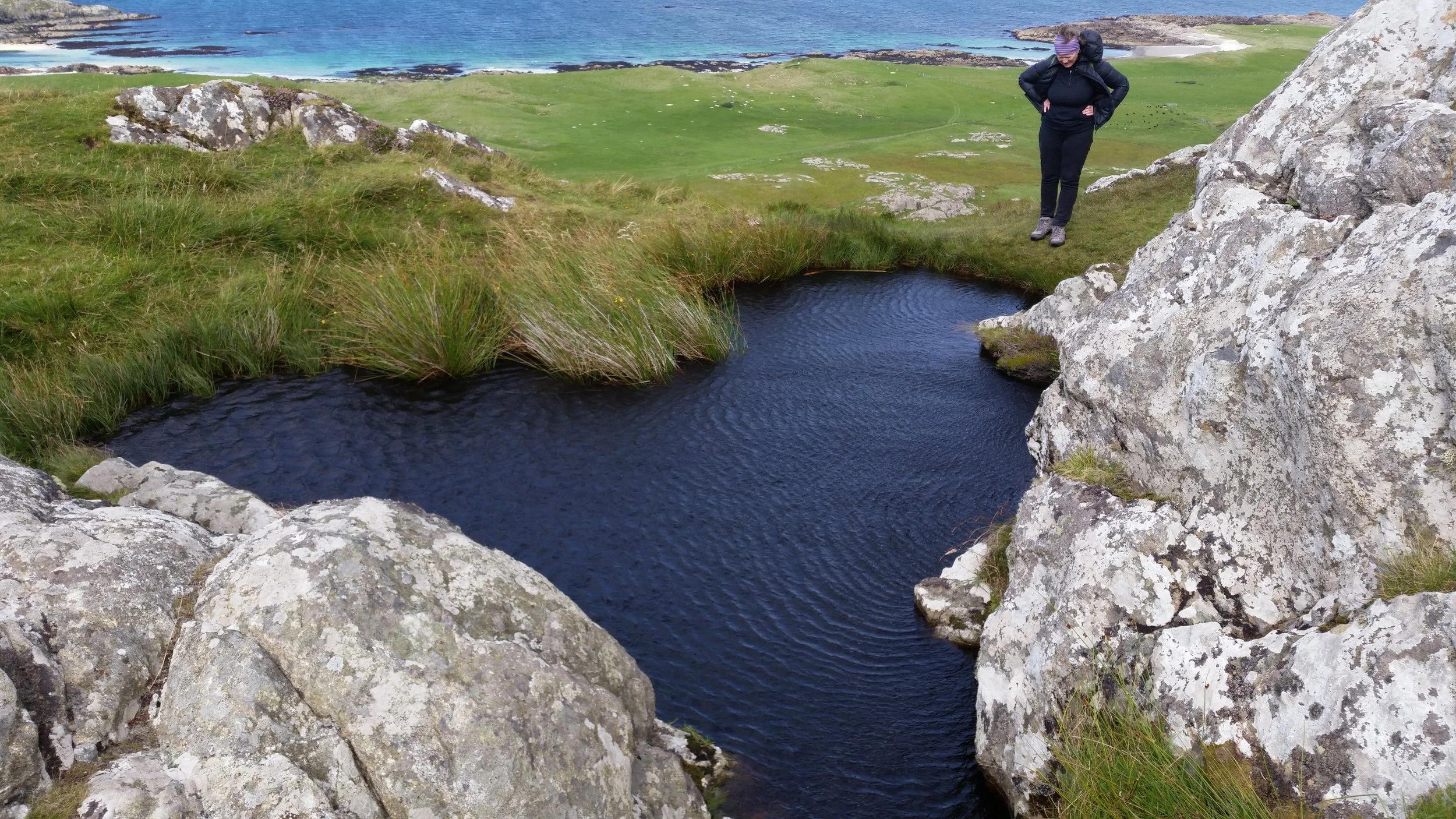Holy Wells
“The purity and life-giving properties of clean, clear water - water that emerges miraculously out of the ground for the benefit of all life - was seen to be a blessing and a gift from Goddess/God,
as well as being a point of access to the Celtic Otherworld.”
Atop Dùn-Ì, a view of the ocean from the Well of Eternal Youth.
Holy Wells have always been, and continue to be, sacred and significant aspects of devotion and prayer throughout the world. There were many hundreds of sacred wells that formed an important part of Britain’s ancient and esoteric history. These wells were full of myths and legends about the healing, divination and oracular benefits that they offered. The Well of Eternal Youth situated on the top of Dùn-Ì, on Iona is one such Holy Well.
In times long, long ago, the veils were thin between the worlds of ethereal guardian spirits of Nature, and humankind. Lakes, streams, waterfalls, springs, mountains, glens, glades, gorges, and gardens - all honoured and respected parts of creation -- were known to possess guardian spirits. And they were given names. Those guardian spirits were and are manifestations of the Divine Feminine spirit world.
Water was honoured and sacred. Water was protected. Water was celebrated.
These guardian and builder spirits were responsible for overseeing the development and maintenance of nature’s vast expression, and for helping to sustain its vital life force. Fairies, elves, gnomes, and all the Celtic Little People that are part of Nature’s immense expression all over the Earth are given different names in different cultures and beliefs. They share similar attributes and characteristics all related to earth, water, fire, air and wind spirits.
Just as each human has a spirit, so too, there are spirits in Nature. The difference is that we humans are mortal, temporarily in a physical body, while Nature spirits are immortal, having no life and death cycle. They belong to unseen kingdoms and queendoms – the Elemental Kingdom, the ‘Sidhe', are all part of the multidimensional expression and majesty of our beautiful Earth.
‘Ladies of the Lakes’ and female ‘Guardians of the Wells’ were an accepted norm. Women in both spiritual and physical aspects were the natural custodians and protectors of Wells. Out of water, from the deep womb of Mother Earth, life is born and re-born. Water and women share a sacred affinity in birthing new life.
The pre-Christian Celts were dedicated to the preservation and protection of the wells and healing waters of their towns and villages. Historically, early churches were built on or beside existing springs, Holy Well sites, and sacred rock sites. The Abbey on Iona is an example of a location where structures have been built over thousands of years near the site of a Holy Well. The Holy Well near the Abbey is located just outside the main entrance.
It was women, together with the ethereal divine feminine aspects of Spirit, who guarded the Holy Wells and Holy Water sites. The ‘Lady of the Lake’ in Arthurian legend is perhaps one of the best known such guardians.
Brighid is the most well-known and beloved Celtic Goddess. She is the guardian of all water, including all the rivers, wells, and streams of the land. I have written more about Brighid here.
With the advent of Christianity, the practice of honouring and praying to sacred Holy Wells, and asking for guidance, divination or healing, came to be regarded as superstitious nonsense. And then, in 1581, during the Protestant Reformation and the subsequent Catholic Counter Reformation, it became illegal to engage in such activities. Worshipping, praying, or otherwise communicating at sacred water sites was outlawed and people were punished for participating in rites and ceremonies that had long served the well-being of their communities.
The ongoing degradation and de-valuing of women intensified and became a dominant aspect of the global repression of women and their wisdom and knowledge. Women’s extensive ancestral knowledge of herbs and natural earth medicines, their skills as midwives, healers, and care-takers of the sick and dying had been developed and passed on to each generation for thousands of years.
Today a majority of ancient Holy Well sites are in various stages of neglect, hidden from view, off the side of highways, in overgrown fields, built over, or they have simply been covered up with the passage of time.
It’s a comfort to know, however, that there are many dedicated people around the world who are honouring the sacred nature of water and working tirelessly to restore Holy Wells to their original esteemed, respected, and honoured natural state. When water is ‘good’, clean, and alive both physically and spiritually, it brings sacredness to our days, and infills Life to our communities.
On Iona, there are two identified Holy Wells, one by the Abbey and one on Dùn-Ì. The one on Dùn-Ì is called, ‘The Well of Eternal Youth’. When these Holy Wells are fully activated once again, it will be a time of great celebration!
Read more about sacred water and the Divine Feminine here: Sacred Water; here: The Well of Eternal Youth; or here: The Pink Lady of the Well.



